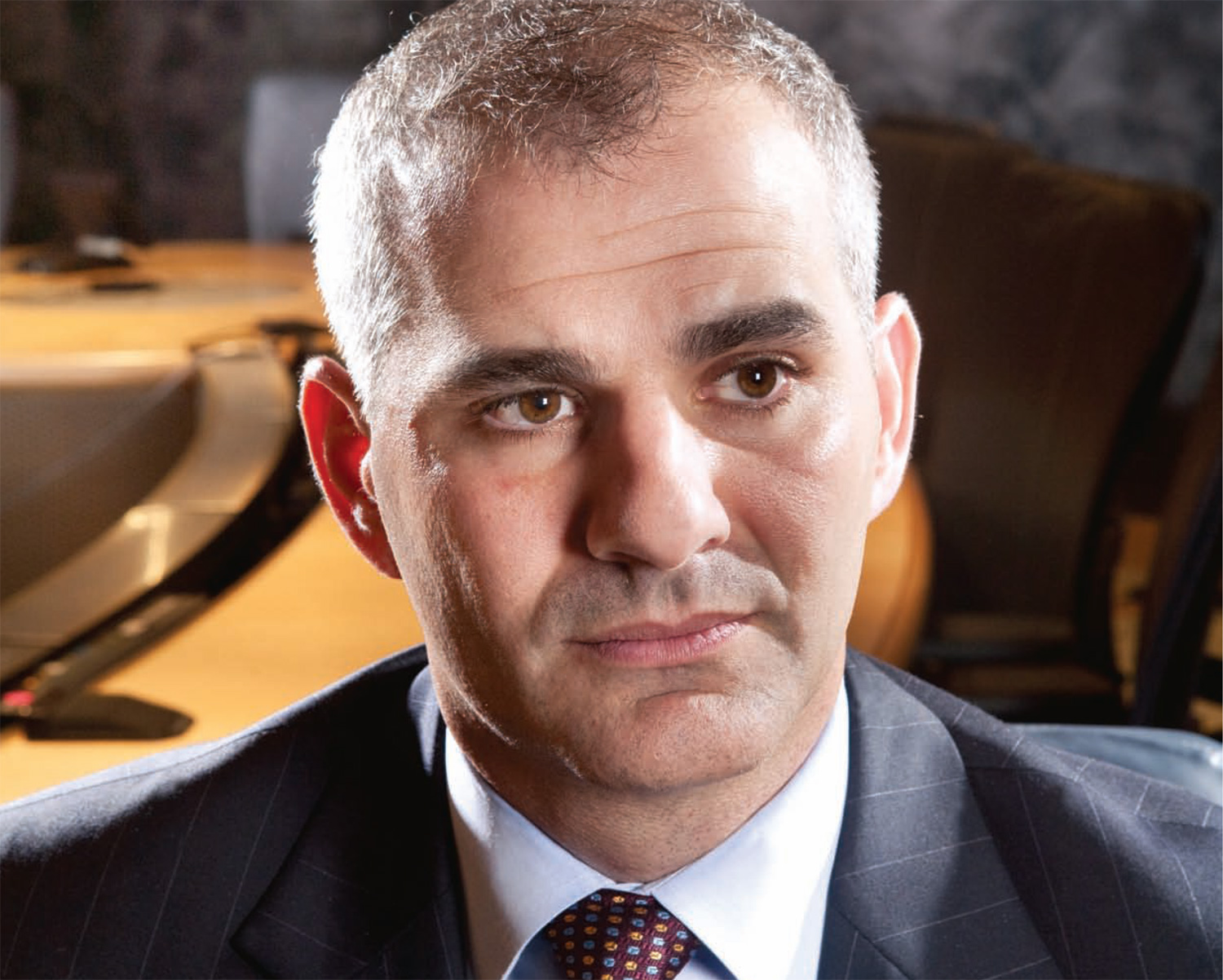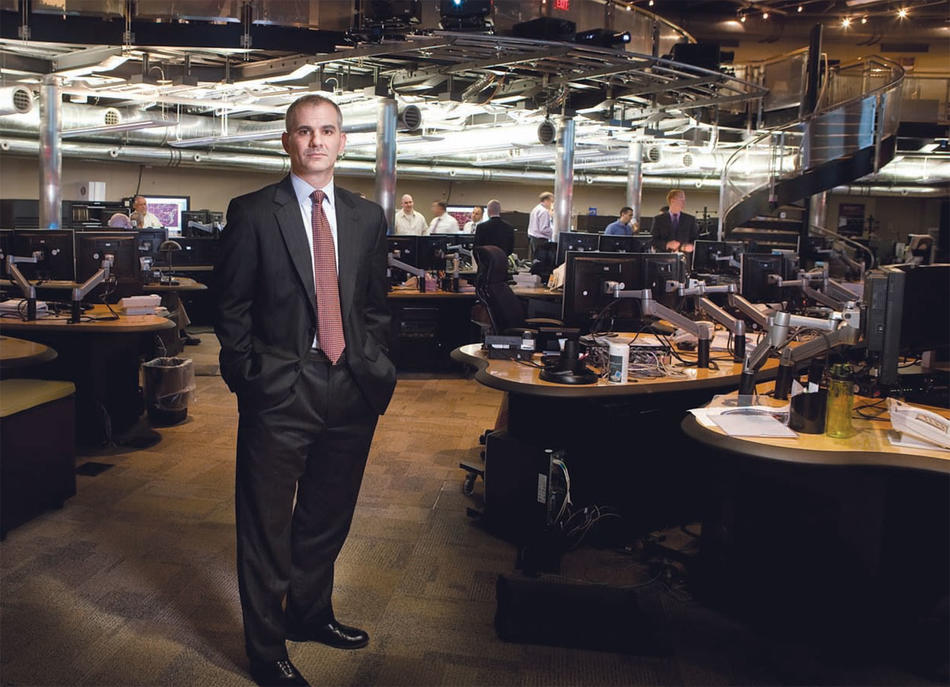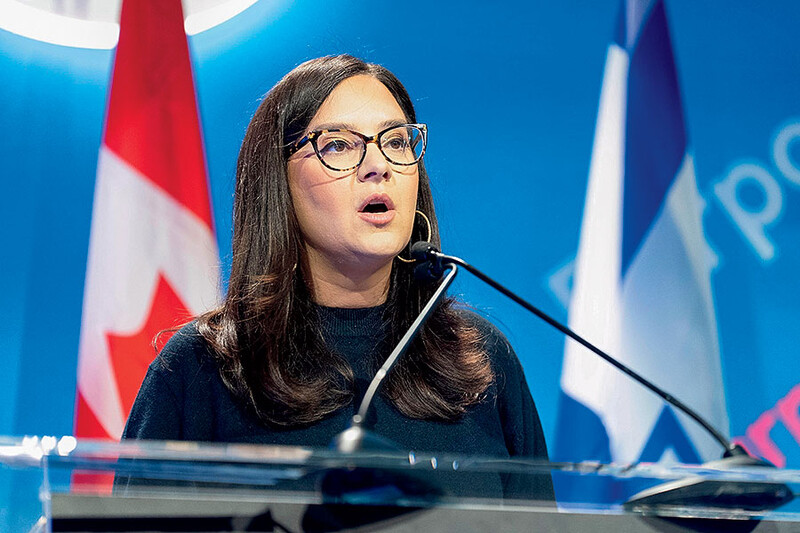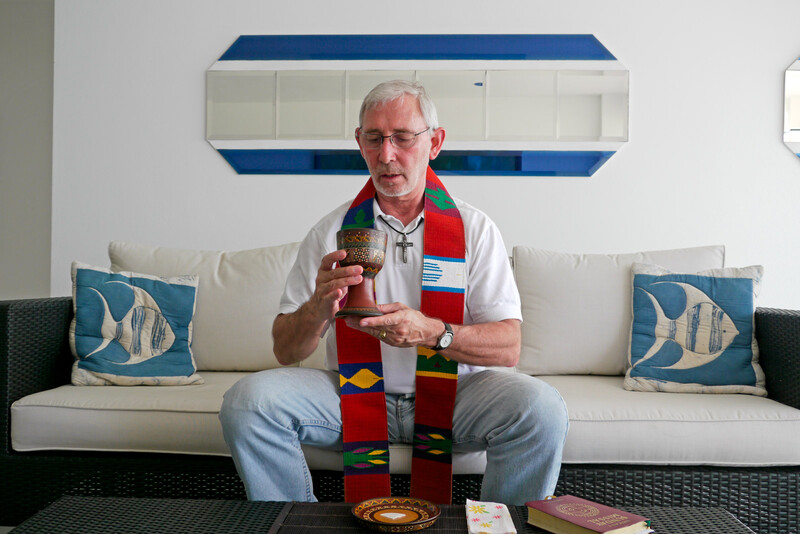
It’s lunchtime on a Wednesday at the National Counterterrorism Center (NCTC), a vast, X-shaped facility of blastproof windows and office-park concrete, located atop a tree-fringed hill in McLean, Virginia. The spacious ground-floor cafeteria is filled with dozens of the organization’s 600 or so employees. Two large flat-screen TVs flash brightly in separate dining areas: one is tuned to the Fox News Channel, the other to CNN. No one pays attention to them.
Upstairs, in a large corner office, Michael E. Leiter, NCTC’s 40-year-old director, greets his one o’clock. Fresh from meetings at the White House with the president’s National Security Council, Leiter ’91CC possesses the chipper momentum of an Ivy League go-getter whose itinerary can include powwows with anyone from a foreign minister to the top cop of Los Angeles. But today, on the eve of the release of NCTC’s compendium of last year’s global terror events, the 2008 Report on Terrorism, Leiter has reserved a slot for something a little less official: he’s going to talk to a university magazine about the current terror threat to the United States.
Such approachability might seem surprising given the cloak of secrecy that surrounded the center when it opened in 2006. Back then, journalists who came to report on the $250 million complex were asked not to mention the location. Today, the mood is less tense, and the efficient bustle of the place and the southern-tinged friendliness of the staff reveal a human side to what is often perceived as a remote and coldhearted business. This receptive spirit is personified by Leiter, whose position stems from a flurry of dramatic, difficult changes that have confronted the intelligence community over the past few years.
As Richard K. Betts, the Arnold Saltzman Professor of War and Peace Studies at Columbia, notes in his book Enemies of Intelligence (2007), “the crying need for intelligence reform is amplified every time intelligence stumbles.” While the spy scandals of the 1980s and ’90s spurred calls for greater discretion in the intelligence community, the failures associated with 9/11 and the invasion of Iraq sent the pendulum in the other direction. The result was what the New York Times called “the biggest restructuring of spy agencies in half a century.”
In August 2004, President Bush established the NCTC by executive order, acting on the 9/11 Commission’s recommendation that the government, to address the dot-connecting problems arising from the barriers between organizations, create a national center “for joint operational planning and joint intelligence, staffed by personnel from the various agencies.” Four months later, Congress passed the Intelligence Reform and Terrorism Prevention Act of 2004 (IRTPA), codifying the center under the newly minted Office of the Director of National Intelligence (ODNI), whose chief (John Negroponte then, Dennis Blair now) would oversee a central “knowledge bank,” as Bush called it, and replace the head of the CIA as the nation’s principal spymaster.
This was problematic. For one thing, agencies tend to guard hard-won information jealously; they like to protect their turf and take credit for success. And adding another bureaucracy to better manage the existing ones was no logistical slam dunk. But, as Betts writes, “disaster makes radical change respectable; indeed, expected.” Political pressures demanded nothing short of a cultural makeover. Methods like “stovepiping” — the funneling of raw intelligence from agencies directly to policy makers, without review by outside analysts — were out. Integration and information sharing were in — modes that could hardly come less naturally to the intelligence community. Turf battles were inevitable. So was Al-Qaeda’s continued plotting. The task of organizing America’s counterterrorism effort was not for the faint of heart.
In November 2007, the director of the NCTC, John Scott Redd, stepped down, citing health problems. Leiter, who had joined the organization eight months earlier as principal deputy director, was made acting director while Bush looked for Redd’s replacement. The search dragged on for months. (In their Newsweek column, “Terror Watch,” Michael Isikoff and Mark Hosenball reported in March 2008 that the buzz in intelligence circles was that Bush, politically weakened, couldn’t attract any big names to the high-pressure post.) Leiter, meanwhile, was growing into the position and winning praise from colleagues. Finally, on March 31, 2008, he was nominated for the directorship by Bush. The Senate confirmed him that June.
This January, President Obama asked Leiter to stay on.
Radiating thoughtfulness and whiz-kid competence, Leiter, who bears a glancing resemblance to Oliver North, has become the public face of American counterterrorism. On any given day, while his agency is helping to prepare the supersensitive President’s Daily Brief (PDB, in this acronym-addled world), or coordinating with government partners via videoconference to discuss the movements of terrorist operatives and their money, or assessing the latest significant threat to what he calls “U.S. interests” and “the U.S. homeland,” Leiter might be standing before an audience at the American Legion, or at a think tank like the Aspen Institute, explaining the challenges of fighting Al-Qaeda and spelling out the NCTC’s mission.
“We are, in short, intended to be a one-stop shop for mapping out the terrorism threat and designing a plan for the U.S. government to counter it,” Leiter told a crowd at the Washington Institute recently. He means international terrorism: the center doesn’t handle pure domestic terrorism of the Timothy McVeigh or Unabomber variety. That’s for the FBI and the Department of Homeland Security (DHS). This line is drawn, as Leiter has said, “to ensure that the apparatus which is developed for international counterterrorism and Al-Qaeda is not inappropriately applied to domestic groups.”
That is probably a good thing.
Mike Leiter grew up in Englewood, New Jersey, and attended Columbia in the footsteps of his father, the surgeon Elliot Leiter ’54CC. Upon graduation, he joined the military and became a naval flight officer, flying EA-6B Prowlers and participating in operations in the former Yugoslavia and Iraq in the 1990s. In 1997, he entered Harvard Law School, where he was elected president of the Harvard Law Review and graduated magna cum laude. This was followed by a clerkship with Supreme Court Justice Stephen G. Breyer, after which Leiter planned to become a prosecutor. But one September morning, while he was inside the Supreme Court building, the unthinkable happened: a passenger jet, American Airlines Flight 77, slammed into the Pentagon. The country was under attack.
That day realigned Leiter’s future. He did become a federal prosecutor in Virginia, fighting organized crime, but found himself increasingly drawn to issues of national security. When the Robb-Silberman Commission was convened by Bush in 2004 to study the U.S. government’s botched intelligence estimate of Iraq’s weapons program, Leiter served as deputy general counsel and assistant director. A new path had opened, and Leiter took it.
Now, as NCTC director, Leiter goes to bed each night with nothing less urgent on his mind than the safety of the country. If he can sleep, it’s in part because the NCTC never sleeps: inside the center’s prefrontal cortex, the prosaically named Operations Center — a large, futuristic chamber of blob-shaped desks, computer terminals, and large overhead plasma screens that invite references to James Bond, if not to Philip K. Dick — analysts from more than 16 intelligence agencies across the U.S. government work round-the-clock in 12-hour shifts to gather and analyze thousands of pieces of information per day. They sift through endless streams of data from sources open and classified, electronic and human, as well as from intercepted communications and satellite photos. This information is then boiled down into intelligence “products” that are distributed to federal partners and, in conjunction with the FBI and the DHS, to state, local, and tribal “consumers,” thus fulfilling IRTPA’s mandate that “the agencies, as appropriate, have access to and receive all-source intelligence support needed to execute their counterterrorism plans or perform independent, alternative analysis.”
Of course, analysis is far from an exact science. While much of counterterrorism is technology-driven, its analysts are still human. As Betts told Columbia, “Research has shown that people do not tend to reason objectively about evidence they get, in that they will often pay more attention and accord greater reliability to intelligence that confirms the belief they already had, and explain away or cite as aberrations the intelligence that doesn’t confirm it.”
That’s one potential advantage of information sharing: the more people who see a piece of intelligence, the less chance for errors of individual judgment. This trend toward a freer flow of information can be found, too, in the center’s public resources, such as the Worldwide Incidents Tracking System (WITS), which is the U.S. government’s database of terror attacks (accessible at wits.nctc.gov), and the downloadable 2008 Report on Terrorism, an exhaustive chronology of terror events across the globe, accounting for nearly 50,000 dead and injured. The list of attacks in Iraq — 11 dead in Diyala, 13 dead in An Nasiriyah, more than 50 dead in Karbala, and on and on, day after day — is particularly disheartening, but it’s the surging violence in Somalia and Afghanistan that really leaps out. The report, compiled from open sources, conveys a concerned, lawyerly precision, carefully defining its standards for what qualifies as a terrorist act and what doesn’t, and providing detailed statistical charts and graphs.
“That’s a big merit of the center,” says Brigitte Nacos, adjunct professor of political science at Columbia and author of the textbook Terrorism and Counterterrorism. “They explain their methodology, so that scholars can use the material.” As for Leiter’s labors with the Hydra that is U.S. intelligence, Nacos is confident: “He’s been with the Director of National Intelligence [since early 2007], so he knows the problems. He knows what has to be done.”
In a field where success mostly goes unnoticed and failure can become a national scandal, it’s nice to hear an encouraging word — especially when family members keep pointing out certain parallels between you and your overachieving boss. Leiter’s been telling a joke at his appearances: “My mother called me up and said, ‘So. You went to Columbia. You went to Harvard Law School. You were president of the Harvard Law Review. Look at him — he’s president! What are you doing?’” Leiter doesn’t mind poking fun at himself. He has the natural affability and humility often found in retired military people. His toughness lies just under the surface, expressing itself not in fighting words but in a resoluteness of purpose and an intellectual command of the operation.
Up in his office, Leiter sits down, along with an NCTC spokesperson, to talk to Columbia about Al-Qaeda, root causes, hearts and minds, and the tensions between intelligence gathering and civil liberties.
The interviewer takes out a digital recorder and turns it on. And, this being the NCTC, Team Leiter does the same.
Leiter: Assessing the threat
The following is taken from Columbia Magazine’s interview with Mike Leiter at the National Counterterrorism Center.
Hot spots
I would identify three areas of the world that are our most significant concern. The first is Afghanistan and Pakistan. For the past eight years this has been Al-Qaeda’s core base, and that hasn’t changed significantly. They’ve certainly been weakened and hurt, especially in the federally administered tribal areas in Pakistan, which is where we’re most concerned about active Al-Qaeda plotting against the U.S. and the West. The second is Yemen. Al-Qaeda has made some gains in Yemen over the past year that are very concerning to us. This is after Al-Qaeda really was down in the Arabian peninsula for a long time, ever since the Saudis took pretty aggressive measures against them. Then there’s Somalia. Clearly the young government there is ripe for the picking for terrorist groups, whether it’s Al-Qaeda or Al-Shabaab. It’s one of the more difficult areas to deal with, given that there’s no central government authority.
The Taliban and Al-Qaeda for many years now have had a close relationship. Taliban in Pakistan and Taliban in Afghanistan — they’re slightly different, but fundamentally, the Taliban and Al-Qaeda see eye to eye enough that both of them are clearly threats to the United States: the Taliban more directly and in more significant numbers to U.S. troops in Afghanistan; Al-Qaeda a significant threat well beyond Pakistan and Afghanistan in terms of planning attacks.
No attacks? No accident.
I’m often asked if it’s a coincidence that we haven’t been attacked since 9/11, and the answer is flatly no. I attribute this to three things. First, the U.S. government is much better prepared and organized; we share information today in ways that we never thought possible on September 10, 2001. Today, the information that flows through this building is from the CIA, the FBI, the military, DHS, all of them coming together to make sure that we don’t have gaps. Second, we’ve elevated our defenses in ways that simply make it a lot harder for Al-Qaeda or its sympathizers to get into or operate in the United States. Some of that obviously has negative repercussions — the way in which we screen travelers, and visas and the like. But it has undoubtedly reduced the risk of a terrorist attack. Finally — and this, too, is not an unmitigated positive — the U.S. government’s offensive actions in Afghanistan and in that region have disrupted attacks and Al-Qaeda’s ability to recruit, train, and send people overseas. I think the leadership structure of Al-Qaeda is probably under more pressure today than it has been for the past eight years.
Who’s at war with Islam?
More than 50 percent of terrorism victims in 2008 were Muslim, which is a very powerful reminder that this is not about the West being at war with Islam. This is Al-Qaeda completely perverting a wonderful, peaceful religion, leading to death and suffering for Muslims in many parts of the world. In places like Jordan that have experienced horrendous suicide attacks, like the bombing of the wedding in Amman in 2005, we have seen that Al-Qaeda’s message has not resonated, in large part because people understand that Al-Qaeda does not have a positive message.
Al-Qaeda’s ultimate goal is to establish a caliphate across the Middle East, into North Africa, and into parts of Asia, and expel the United States and Westerners and Israel from that caliphate. This is still at the core of their mission; they believe this, and they believe it very strongly. I wouldn’t try to attribute one set of reasons to everyone who identifies with this vision. They have a variety of reasons. American and Western policies have certainly had an influence, as has corruption in their own countries, a lack of what they believe is a true political voice, and a lack of economic opportunity. There are a wide variety of drivers behind why a 19-year-old in Yemen or Somalia or Islamabad or Morocco would identify with Al-Qaeda.
Civil liberties v. good intelligence
We have very strict guidelines about how information is controlled and how it can and cannot be retained within our systems. I have a relatively small team of lawyers who monitor everything we do, and we work hand in hand with the Civil Liberties Protection Officer within the Director of National Intelligence to make sure that the information, however it’s collected, is being protected properly, and that it’s seen only by the people who need to see it.
I don’t think there is an inherent tension between good intelligence and civil liberties. Having been an attorney, having been at the Supreme Court on 9/11 as a law clerk, I believe that good intelligence can and should complement the protection of civil liberties. We have the technology to find out why someone looked at specific data, and if it wasn’t for the right reason, that individual needs to be disciplined or fired. I think more broadly, since 2001, the United States is still a little unsure about what it wants out of its intelligence organizations, especially domestically. If you go back and read the 9/11 Commission Report, you’ll see an enormous amount about the need to ensure that the intelligence community is aggressively trying to figure out where plots are, connecting the dots, and then sharing information. Eight years after 9/11, that’s not what most of the discussion is about. Most of the discussion is now about perceived overreaching of different intelligence organizations and the need to rein them in. I think there has to be a healthy balance between these two poles, and I’m not quite sure we’ve reached it yet. That can be a challenge for those of us who do this and who are totally committed to protection: that means protecting people against attack, and protecting their civil liberties. What I try to tell my people is, if we stop an attack, but people feel as if their civil liberties are being impinged, then we haven’t won. We’ve lost, we’ve just lost in a different way.
The right set of tools
The nature of terrorism is such that it’s almost impossible to understand all of its different facets. I think it’s very important to have a balanced education, which gives us an ability to look at a lot of different problems from multiple perspectives. The education at Columbia doesn’t make you an expert at Greek literature, it doesn’t make you an expert in physics. What it does is give you an ability to reason, to think about hard problems. I’m a lawyer by training, with a military background, but whatever the problem is, I — as a leader, and I hope this organization as a whole — have an ability to apply the right set of tools to the right problem. It doesn’t hurt that when I was graduating from Columbia one of the jobs I thought about taking was to be a New York City police officer. I took the test and I got hired. I also worked on CAVA, the volunteer Columbia ambulance. Now I work with everyone from first responders, who are police and fire and ambulance, to the military in Afghanistan, and everything in between. So the experiences I got at Columbia turned out to be more applicable than I think I would have imagined.
Looking ahead
What I hope to see five years from now is a diminished risk of attack within the United States — and I stress diminished risk, not eliminating the risk, because I don’t think that’s realistic. But a diminished risk, for three reasons. One, because we have hurt Al-Qaeda. Two, because the U.S. government is simply better at defending itself — through intelligence, through law enforcement, through border security — and we can do it in a more targeted way that people feel more comfortable with. There are fewer questions about our improperly infringing on people’s civil liberties. And third, because Al-Qaeda’s message simply isn’t resonating with the world.
I think that is where we’ve moved the least effectively over the past eight years in many ways — combating that message and building our own message: The U.S. is not at war with Islam. Al-Qaeda is at war with Islam. The U.S. and Muslim-majority countries throughout the world are actually a partnership, and that partnership involves combating Al-Qaeda, but also building hope inside those countries. It’s about messaging through both words and action; it’s providing the aid that can build the schools that can teach the children and create economic opportunity, and showing that our power will be used to help these nations and these people advance in a way that Al-Qaeda doesn’t even pretend to offer.
That’s where I hope to be in five years. The greatest thing would be for the threat of terrorism to become so diminished that it causes the NCTC to shrink and turn out to be unnecessary. That’s the ultimate goal — to put myself out of work.



